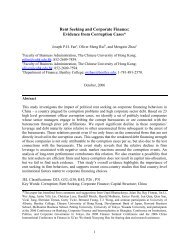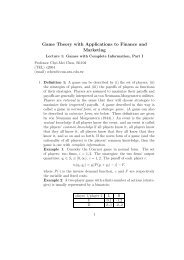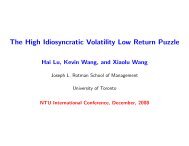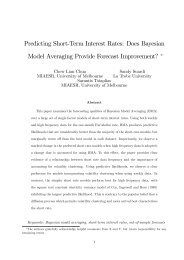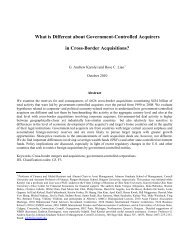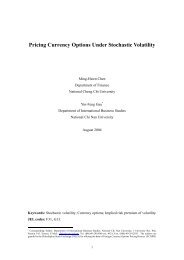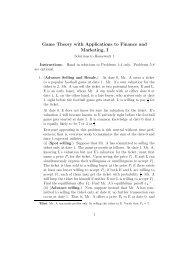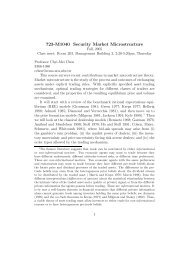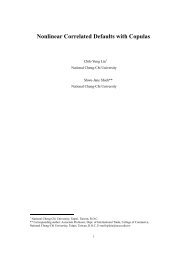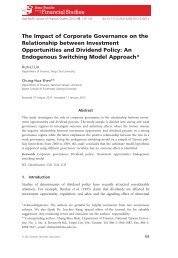Game Theory with Applications to Finance and Marketing
Game Theory with Applications to Finance and Marketing
Game Theory with Applications to Finance and Marketing
You also want an ePaper? Increase the reach of your titles
YUMPU automatically turns print PDFs into web optimized ePapers that Google loves.
26. Example 8. Consider the following variant of the duopolistic industry<br />
examined in Example 6. Here the main difference is that the two firms<br />
are faced <strong>with</strong> dem<strong>and</strong> uncertainty. Assume that<br />
• Show that p A<br />
= p B<br />
− 3. To see this, note that since p B<br />
> 2, firm A should try <strong>to</strong><br />
extract rent from consumer 1, <strong>and</strong> for that purpose alone, p A<br />
should be as close <strong>to</strong><br />
2 as possible. However, firm A also wants <strong>to</strong> compete for consumer 2. But even for<br />
the latter purpose, there is no reason for firm A <strong>to</strong> price below p B<br />
− 3. Now, you<br />
can argue from firm B’s perspective that, similarly, p B<br />
cannot be less than p A<br />
+ 3.<br />
• Let the equilibrium profits of the two firms be denoted by π A <strong>and</strong> π B . Since p j<br />
has <strong>to</strong><br />
be a pure-strategy best response for firm j, <strong>and</strong> since when using such a lower-bound<br />
price, firm j wins consumer 2 for sure, show that π A = 2p A<br />
<strong>and</strong> π B = p B<br />
.<br />
• Show that p A = 2. If instead p A < 2, then since firm B does not price above p A + 3,<br />
this means that p B < 5, a contradiction <strong>to</strong> the result established earlier that p B = 5.<br />
• Show that for all p A ∈ [p A , 2), <strong>and</strong> for all p B ∈ [p B<br />
, 5),<br />
F A (p A ) = 1 −<br />
π B<br />
p A + 3 , F B(p B ) = 2 − π A<br />
p B − 3 .<br />
• Using the previous step <strong>to</strong> conclude that ∆F A (2) > 0. If instead that F A (2−) = 1,<br />
then π B = 0, which is impossible because firm B can always price at p B<br />
<strong>and</strong> get a<br />
profit p B<br />
> 2.<br />
• Show that ∆F B (5) = 0.<br />
• Show that firm A when pricing at 2 must lose consumer 2 for sure, thereby concluding<br />
that π A = 2.<br />
• Show by using the previous step that p A<br />
= 1.<br />
• Show by using the result p A<br />
= p B<br />
− 3 that p B<br />
= 4.<br />
• Show by using the result π B = p B<br />
that π B = 4.<br />
• Give a complete characterization for (F A (·), F B (·)).<br />
• Verify easily that, given the equilibrium F B (·), pricing outside [p A<br />
, p A ] cannot be<br />
optimal for firm A in equilibrium.<br />
• Verify easily that, given the equilibrium F A (·), pricing over (−∞, 1) or over (2, 4) or<br />
over (5, +∞) cannot be optimal for firm B.<br />
• As a last step, verify that for firm B, given the equilibrium F A (·), neither pricing at<br />
p B = 2 nor pricing over [1, 2) can generate a payoff higher than π B = 4.<br />
Note that initially there do not exist loyal cus<strong>to</strong>mers in the game. However, given the<br />
strategy F B (·), consumer 1 becomes a loyal cus<strong>to</strong>mer for firm A. Loyalty of a consumer is<br />
thus endogenously determined by the firms’ equilibrium strategies.<br />
29



